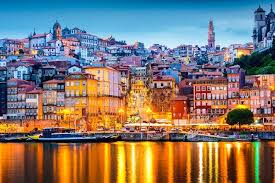To visit Northern Portugal, ditch guidebooks and ask for local advice

Tom Mullen
Lisbon: It’s easy to transform vacation into work: list travel goals to achieve within a deadline. Consider holidays as a project management checklist to perform while catching a tan or buying foreign refrigerator magnets. Don’t bother adjusting your thinking—just add a suitcase and train tickets printed in a foreign language to your life and sip on gin and tonics mid-afternoon rather than during the evening.
Back home you will be satisfied at having met your travel goals, but likely mystified why every place you visited was so crowded.
Porto is the name of a city in northern Portugal with a population of a quarter million residents. However, the Greater Porto Metropolitan Area is a larger sprawling area with a population of more than 1.5 million residents within 17 municipalities.
Tourism to the region continues to grow. Greater Porto Metropolitan Area had 11.5 million overnight stays in 2023 (of which 5.9 million were within Porto city) and 14 million overnight stays in 2024 (6.2 million were within Porto city).
The ‘must-see destinations’ within this region are listed all over the internet. In reading about them, you will not be alone. Ample list checkers geared up for weekend visits are keen to tick off boxes regarding their desired destinations.
If you travel there—whether to Porto city itself, or to Matosinhos, Maia, Vila Nova de Gaia or any of 13 other municipalities, consider wandering away from recommended locations, or escaping the bustle of city life to visit rural landscapes to sample vinho verde wines or enjoy coastal sports or explore highlands. If you decide to take a tour, consider one that will take you to lesser known locales with fewer crowds.
“We want people to stay longer and to visit more of the region,” Madalena Dinis explained when I asked her about Porto. She directs marketing and communications for Associação de Turismo do Porto e Norte—Visit Porto and North of Portugal, a 30-year old non-profit organization dedicated to developing the influx of visitors.
“We’re not targeting one-to-two-day visitors or those with the ‘express visit checklist,’ but instead nature lovers and people who stay longer and are interested in culture and communities, because we have strong community ties in the north of Portugal.”
My own advice for travel is simple: choose one or two anchor points as a base for when you arrive, then ditch all guidebooks/web search results and ask the locals about where to visit.
Delving into learning about local foods can provide geographical, historical and cultural context. The municipality of Matosinhos, for example, takes pride in the rich flavors of its seafood, derived from nutrient abundant ocean waters. Try sampling regional favorites, such as a tiger prawn moqueca with basmati rice; moqueca is a Brazilian fish stew mixed with onions, garlic, bell peppers and cilantro. Or sample amberjack sashimi with teriyaki sauce. Or learn about the history of local foods by taking a vibrant tour through one of four sardine canneries in the region.
Consider also taking a brief immersive language course. Portuguese is the eighth mostly widely spoken language on earth, used by 10.3 million residents of Portugal, as well as 213 million Brazilians and 72 million residents of Angola and Mozambique in Africa.
Eat a lavish and slow dinner, maybe at a restaurant with a vista. Start with sourdough bread and a glass of port tonic (white port wine with tonic water) before sampling codfish salad with onion jam, or a cheese salad with spinach, raisins and almonds and a main course of sole with apple vinegar, or alheira—poultry or game, such as smoked rabbit and pork, mixed with bread, olive oil, paprika and spices and pan fried or barbecued. Pair this with a red Douro wine, such as a Quinta do Vesúvio—a bucket of aromas of raspberries, strawberry jam and molasses from a blend of three grape varieties endemic to Portugal—Touriga Franca, Touriga Nacional and Tinta Amarela. During past visits to this region I’ve enjoyed dinner at Vinum in Nova de Gaia, or Vila Foz in Porto or lunch at Cantinho do Avillez. But ask locals for advice—because chefs change and quality can oscillate over time.
It’s often best to visit locations before late morning, because crowds are sparser and summer heat has not peaked. Keep your afternoons more sedate. If you want to visit a market such as Bolhão in Porto or Mercado Municipal de Matosinhos—try going early: the Porto market opens at 8:00 a.m and that in Matosinhos at 6:30 a.m. You can buy fresh fish from vendors and have it cooked for lunch at restaurants located within these markets. Or order dishes from their blackboard menus—including prego do lombo, loin steak sandwich, or xerem de raia—skate with corn kernels. Sample your food with a glass of white wine from the vinho verde appellation, such as one made from the Trajudura grape (known as Treixadura in neighboring Spain).
Portugal’s coastline throbs with beach goers and sports enthusiasts. Drive some 40 miles [65 kilometers] north of Porto to visit Viano do Castelo, a coastal city and municipality at the mouth of the Lima River. This is part of the Costa Verde or Green Coast. You can take lessons in kite surfing or rent bicycles or stay in a sport hotel next to an attractive town known for cod fishing, local arts and parades where participants display local garb.
If you enjoy wine, sample those from the local vinho verde appellation, with low alcohol, high acidity and often including effervescence. For a recommendation of a winery to visit, ask staff at your hotel or a sommelier at a restaurant that you appreciated.
In summary—for late summer of fall travel, consider staying in any region for longer than a weekend, asking locals where to dine, ditching guidebooks and internet lists, exploring the countryside outside cities and waking up early to foray.
As Robert M. Pirsig wrote in his book Zen and the Art of Motorcycle Maintenance, “Sometimes it’s a little better to travel than to arrive.”





